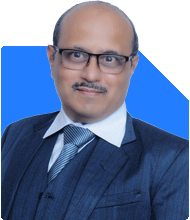Ramalingam Kalirajan |8778 Answers |Ask -Follow
Mutual Funds, Financial Planning Expert - Answered on Jun 28, 2024
He has an MBA in finance from the University of Madras and is a certified financial planner.
He is the director and chief financial planner at Holistic Investment, a Chennai-based firm that offers financial planning and wealth management advice.... more

I am 27 year old female. I have a one year old son. My husband and I earn 120000 per month. We have monthly sips of 50000. How do you suggest we allocate the funds in order to achieve our goals of buying a house and our son's higher education
Compliments and Appreciation
Firstly, congratulations on your disciplined savings habit and commitment to your financial goals. It's impressive to see such foresight and dedication to securing your family's future. Your approach to systematic investment planning (SIPs) is a strong foundation for achieving your financial objectives.
Understanding Your Goals
Before diving into fund allocation, it's important to clearly define your financial goals. You have two primary goals: buying a house and funding your son's higher education. Both goals have different timelines and financial requirements.
Buying a House
Purchasing a house is a significant financial commitment. Determine the time frame for this goal. If you plan to buy a house in the next 5-10 years, you need a strategy to accumulate the down payment and manage the EMIs.
Son’s Higher Education
Your son’s higher education is another crucial goal. Considering the rising cost of education, it's essential to start early. You have about 17 years to build a substantial corpus for this purpose.
Current Financial Situation
You and your husband earn Rs 1,20,000 per month. With Rs 50,000 allocated to SIPs, you have Rs 70,000 remaining for other expenses and savings. It's important to maintain a balanced approach to ensure you meet both your short-term and long-term goals.
Risk Tolerance and Investment Horizon
Assess your risk tolerance and investment horizon. Given your age and the long-term nature of your goals, you can afford to take more risks. Equity-oriented investments are suitable for long-term growth but should be balanced with some debt investments to reduce risk.
Diversification
Diversifying your investments is crucial. It spreads risk across different asset classes and sectors, reducing the impact of any single investment’s poor performance. A well-diversified portfolio balances risk and return effectively.
Allocating Funds for House Purchase
To buy a house, you need to accumulate a down payment. Here’s how you can allocate your SIPs for this goal:
Equity Mutual Funds: Allocate a significant portion to equity mutual funds. They offer higher returns over the long term, helping you accumulate the required amount faster. However, they come with higher risk, so diversify across large-cap, mid-cap, and multi-cap funds.
Debt Mutual Funds: Allocate a smaller portion to debt mutual funds. They provide stability and reduce overall portfolio risk. These funds are less volatile and provide steady returns.
Short-term Debt Instruments: As you approach your goal, shift a portion of your equity investments to short-term debt instruments. This protects your corpus from market volatility.
Allocating Funds for Son’s Higher Education
For your son’s higher education, a long-term investment strategy is essential. Here’s how you can allocate your SIPs for this goal:
Equity Mutual Funds: Given the long investment horizon, allocate a significant portion to equity mutual funds. They offer higher returns, and the power of compounding can significantly grow your investments over time. Focus on diversified equity funds to spread risk.
Child Education Plans: Consider child-specific mutual funds or education plans. These funds are tailored to meet the future education expenses of children. They come with a lock-in period, ensuring disciplined savings.
Balanced Funds: Allocate a smaller portion to balanced or hybrid funds. These funds invest in both equity and debt instruments, providing a balanced approach to risk and return.
Regular Funds vs. Direct Funds
Direct funds have lower expense ratios as they do not involve intermediaries. However, they require more active management and market knowledge. Investing through a Mutual Fund Distributor (MFD) with CFP credentials offers professional guidance, helping you navigate complex market conditions effectively.
Disadvantages of Index Funds
Index funds may seem attractive due to their lower expense ratios, but they merely track the market. They do not offer the potential for higher returns that actively managed funds can provide. Actively managed funds have fund managers who make strategic decisions to outperform the market.
Emergency Fund
Before aggressively investing, ensure you have an emergency fund. It should cover 6-12 months of your expenses. This fund acts as a financial cushion during unexpected situations, ensuring you don’t have to withdraw from your investments prematurely.
Insurance Coverage
Ensure adequate health and life insurance coverage. Health insurance protects against high medical expenses, while life insurance secures your family’s financial future in your absence. Consider term insurance for higher coverage at lower premiums.
Monitoring and Reviewing Investments
Regularly monitor and review your investments. Market conditions and personal circumstances change over time. A yearly review with a Certified Financial Planner can help ensure your investments remain aligned with your goals.
Financial Discipline
Financial discipline is crucial for long-term success. Consistently invest through SIPs, avoid unnecessary expenses, and focus on saving and investing. This disciplined approach will help you achieve your financial goals.
Tax Efficiency
Mutual fund investments offer tax benefits, especially equity-oriented funds. Long-term capital gains (held for more than one year) from equity funds are taxed at a lower rate. Additionally, ELSS (Equity Linked Savings Scheme) funds offer tax deductions under Section 80C of the Income Tax Act.
Creating a Financial Plan
Creating a comprehensive financial plan is essential. It involves setting clear financial goals, assessing risk tolerance, diversifying investments, and regularly reviewing and adjusting the plan. A Certified Financial Planner can help create and maintain a robust financial plan.
Avoiding Common Pitfalls
Common investment mistakes include withdrawing investments prematurely, lack of diversification, and not accounting for inflation. Avoid these pitfalls by sticking to the investment plan, diversifying the portfolio, and regularly reviewing the financial plan.
Retirement Planning
While focusing on these goals, don’t neglect retirement planning. Allocate a portion of your investments towards retirement. The earlier you start, the more you benefit from compounding. Consider a mix of equity and debt investments for long-term growth and stability.
Benefits of Starting Early
Starting early provides a significant advantage due to the power of compounding. Even small, regular investments can grow substantially over time. The earlier you start, the more your money will work for you.
Role of Certified Financial Planner
A Certified Financial Planner can provide personalized advice and help optimize your investment strategy. They offer expert guidance, portfolio management, and ensure your financial goals are met effectively.
Future Income Streams
Consider other potential income streams in addition to mutual funds. These could include part-time work, consulting, or freelance opportunities. Diversifying income sources can provide additional financial security.
Building Wealth Over Time
Wealth creation is a long-term process. Staying invested, being patient, and avoiding panic during market volatility are key. Stick to the investment plan, make adjustments as needed, and let the power of compounding work over time.
Systematic Withdrawal Plan (SWP)
In the future, if you need regular income from your investments, you can opt for a Systematic Withdrawal Plan (SWP). SWP allows investors to withdraw a fixed amount regularly, providing a steady income stream.
Final Insights
Your disciplined approach to saving and investing is commendable. By continuing your SIPs, diversifying your investments, and regularly reviewing your financial plan, you can achieve your goals of buying a house and securing your son’s higher education. Encourage regular discussions with a Certified Financial Planner to optimize your strategy and stay on track. Your dedication and foresight will ensure a financially secure future for your family.
Best Regards,
K. Ramalingam, MBA, CFP,
Chief Financial Planner,
www.holisticinvestment.in
You may like to see similar questions and answers below
Ramalingam Kalirajan |8778 Answers |Ask -Follow
Mutual Funds, Financial Planning Expert - Answered on May 27, 2024
Ramalingam Kalirajan |8778 Answers |Ask -Follow
Mutual Funds, Financial Planning Expert - Answered on Jul 15, 2024
Ramalingam Kalirajan |8778 Answers |Ask -Follow
Mutual Funds, Financial Planning Expert - Answered on Jul 09, 2024
Ramalingam Kalirajan |8778 Answers |Ask -Follow
Mutual Funds, Financial Planning Expert - Answered on Aug 20, 2024
Nitin Narkhede |79 Answers |Ask -Follow
MF, PF Expert - Answered on May 19, 2025
Dr Nagarajan J S K |650 Answers |Ask -Follow
NEET, Medical, Pharmacy Careers - Answered on Jun 03, 2025

Why couldn't you succeed? The reason may be that you completed your undergraduate degree simultaneously. If you had planned properly, you would have been able to pass the NEET exam. Unfortunately, that didn't happen.
NO. Once again, you seem to be making a mistake. Why did you choose Public Health? Do you understand its scope? If you don't, then why are you pursuing it?
Let me remind you that anyone can appear for NEET after completing a BSc. Here are the requirements.
B.Sc. Examination of an Indian University provided that he/she has passed the B.Sc. Examination with not less than
two of the subjects Physics, Chemistry, Biology (Botany, Zoology)/Biotechnology and further that he/ she has passed
the earlier qualifying examination with Physics, Chemistry, Biology, and English.
BEST WISHES.
POOCHO. LIFE CHANGE KARO!
What is the major and ancillary subjects in UG?
Dr Nagarajan J S K |650 Answers |Ask -Follow
NEET, Medical, Pharmacy Careers - Answered on Jun 03, 2025
Dr Dipankar Dutta |1538 Answers |Ask -Follow
Tech Careers and Skill Development Expert - Answered on Jun 03, 2025
Dr Dipankar Dutta |1538 Answers |Ask -Follow
Tech Careers and Skill Development Expert - Answered on Jun 03, 2025
Dr Nagarajan J S K |650 Answers |Ask -Follow
NEET, Medical, Pharmacy Careers - Answered on Jun 03, 2025
Dr Dipankar Dutta |1538 Answers |Ask -Follow
Tech Careers and Skill Development Expert - Answered on Jun 03, 2025
Dr Dipankar Dutta |1538 Answers |Ask -Follow
Tech Careers and Skill Development Expert - Answered on Jun 03, 2025
Dr Dipankar Dutta |1538 Answers |Ask -Follow
Tech Careers and Skill Development Expert - Answered on Jun 03, 2025
Dr Dipankar Dutta |1538 Answers |Ask -Follow
Tech Careers and Skill Development Expert - Answered on Jun 03, 2025
Dr Dipankar Dutta |1538 Answers |Ask -Follow
Tech Careers and Skill Development Expert - Answered on Jun 03, 2025




















